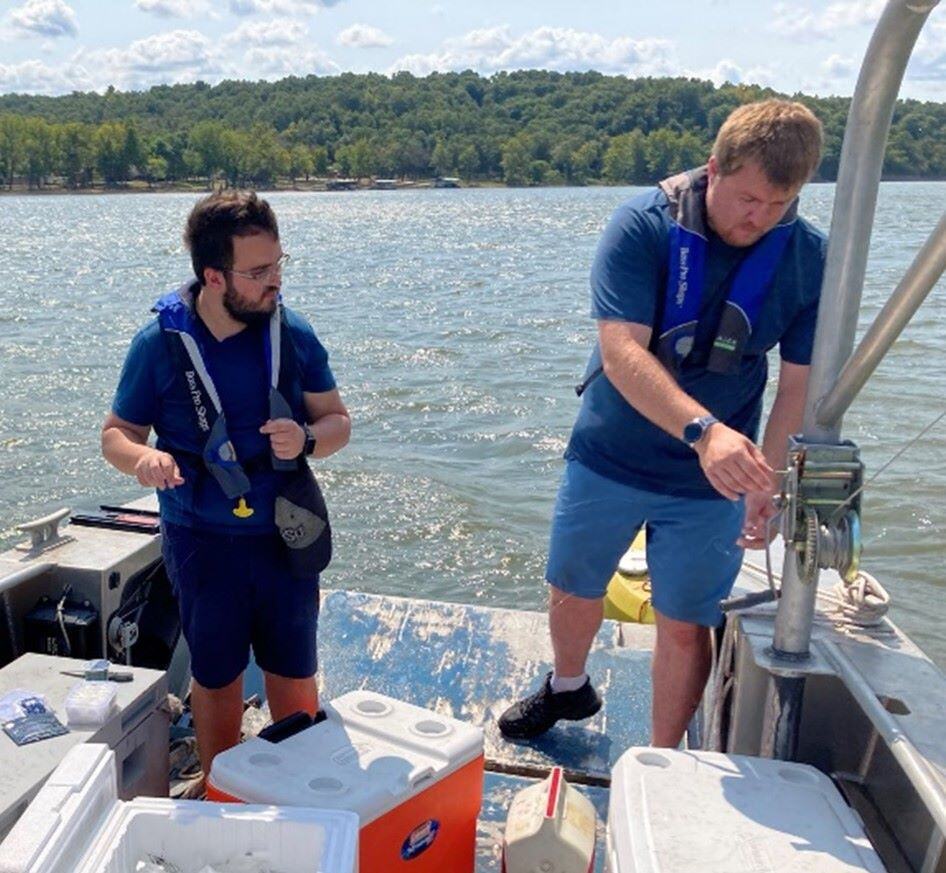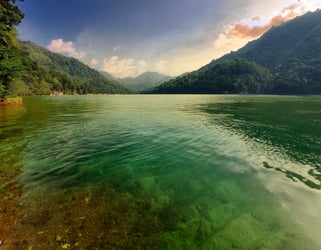Harmful algal blooms (HABs) can have major economic impacts in waterbodies where people frequently recreate, and being able to predict HABs is important to protect public health. Excess nutrients like nitrogen (N) and phosphorous (P) are major contributors to the proliferation of HABs, but some research has shown that the relative supply of N and P alone does not necessarily provide accurate predictions required for reliable forecasting.1Characterizing nuances like this is important to help improve HAB forecasting, especially in large waterbodies like Grand Lake in Oklahoma.
Photo: Yetkin Ipek (PhD Candidate at Oklahoma State University, left) and Bill Mausbach (Watershed Ecologist at Grand River Dam Authority, right) collecting phytoplankton samples.
A University and Power Company Partnership
 Grand Lake is the third-largest reservoir in Oklahoma and one of the most popular recreation destinations in the region, with over one million annual visitors.2 In 2018, people spent a total of $599 million on water-based recreation, including competitive fishing.3
Grand Lake is the third-largest reservoir in Oklahoma and one of the most popular recreation destinations in the region, with over one million annual visitors.2 In 2018, people spent a total of $599 million on water-based recreation, including competitive fishing.3
The Grand River Dam Authority (GRDA) is Oklahoma’s largest public power electric utility and a steward of Grand Lake. Two key pillars of GRDA’s mission are economic development and environmental stewardship, and GRDA funds research projects—especially student projects—that support this mission.
“We have 10-year partnerships with several universities in Oklahoma,” according to Bill Mausbach, Watershed Ecologist at GRDA. “Our partnerships with OSU and the University of Oklahoma fund graduate student research fellowships.” Yetkin Ipek, a PhD candidate in the Department of Integrated Biology at OSU, is the recipient of such a fellowship.
“GRDA is putting a lot of emphasis on water quality in Grand Lake, on top of being a power management company,” Ipek said.
Ipek’s research investigated whether elements other than N and P significantly impact phytoplankton composition and abundance across different sites and seasons, helping to better characterize the drivers of HABs.
“In this study, we are trying to underline spatial heterogeneity and implications for management,” said Ipek. "We’re not debating that N or P doesn’t have an effect, but in real-life scenarios, we can’t make accurate predictions using N and P alone. Different nutrients or environmental factors also have varying degrees of effect on how much they promote or restrict phytoplankton growth.”
Efficient Sampling Strategies for Trace Elements: Capturing Variability Across Sites, Depths, and Seasons
 Trace elements are biologically indispensable but can be highly variable in supply and bioavailability: this required Ipek to design a sampling strategy to capture that variability. In practice, this meant sampling across multiple sites, depths, and months and additional bioassays done in triplicate, which added up to over 200 samples. For a project of this scale, Ipek needed a way to process many samples very quickly that could also provide intelligence on the abundance and types of cyanobacteria present.
Trace elements are biologically indispensable but can be highly variable in supply and bioavailability: this required Ipek to design a sampling strategy to capture that variability. In practice, this meant sampling across multiple sites, depths, and months and additional bioassays done in triplicate, which added up to over 200 samples. For a project of this scale, Ipek needed a way to process many samples very quickly that could also provide intelligence on the abundance and types of cyanobacteria present.
Photo: A map of Grand Lake with the team's study sites (pink), Pensacola Dam (orange), and various fishing outfitters and guide services that help drive water-based recreation and economic development.
Enhancing Chlorophyll Measurement: Faster, More Accurate Colony Counts with FlowCam
The team used a sonde to measure total chlorophyll, but this type of study also needed to be able to distinguish the relative contributions of different taxonomic groups. “[Chlorophyll] is a good proxy for productivity, but getting direct colony counts per milliliter from FlowCam worked much better in our case,” said Ipek. “In the past, we had to count the samples on a hemocytometer, which would take hours just for a few samples.” With GRDA’s FlowCam, Ipek could get the same data in ¼ to ⅙ of the time as he could using a hemocytometer.
But it wasn’t just the speed of data acquisition that mattered.
“[The value of FlowCam comes] not just from cutting back on the duration of measurements compared to hemocytometer counts, which is a big plus: it's also the eye strain and effort spent looking down a microscope with a clicker for hours on end…it’s not just the time savings, but also the effort involved that makes the difference.”

GRDA experienced a major HAB event in Horse Creek in 2021 (left)5. They used FlowCam Cyano (center) to characterize the bloom, which was dominated by Microcystis (right).4
Seasonal Variations in Phytoplankton: Cyanobacteria and Iron Dynamics Revealed by FlowCam
Using FlowCam, Ipek demonstrated that phytoplankton community structure differed significantly among sites and seasons. Of the four sites sampled, Horse Creek had the highest abundance of cyanobacteria, and cyanobacteria were most prevalent in October. Noting that Horse Creek favored cyanobacteria more than any other site, Ipek chose this location as a benchmark for comparing the concentration of 24 different elements, including iron, across 3 different phases (dissolved, bioavailable, and particulate).
Ipek was struck by the difference in how iron is processed between dissolved and bioavailable phases. Iron had an inverse relationship with cyanobacteria in both instances and across all sites. This points to differences in how cyanobacteria process iron compared to other algae. Knowledge of how trace elements like iron drive changes in phytoplankton community structure is important to better understand and predict the type and severity of HABs at different sites throughout the year.
"We have long suspected that differences in water chemistry may be a contributing factor to why we see cyanobacteria blooms in specific coves on Grand Lake. However, we seldom observed meaningful differences in water quality between the coves when conducting our routine monitoring. Ipek’s project is the first time that we have looked at differences in trace elements across the lake and their impacts on the phytoplankton community. Cyanobacteria blooms are difficult to predict and manage, so knowing that there are additional elements that may be influencing their growth in specific coves helps us make informed decisions on where to focus our management efforts."
- Bill Mausbach, Watershed Ecologist for GRDA.
Beyond N and P: The Role of Trace Metals in Predicting Harmful Algal Bloom
Traditional HAB models that only account for N and P are not always the most accurate at predicting when or where an HAB will occur. Evidence suggests that other elements also control the abundance of different types of phytoplankton and cyanobacteria, and this study's results are consistent with previous observations. Even when N and P supplies are constant, differences in trace metals can significantly impact the amount of phytoplankton that grows, what types are dominant, and how elements are processed.
“In this study, we are trying to underline spatial heterogeneity and implications for management” , "We’re not debating that N or P doesn’t have an effect, but we can’t make accurate predictions using N and P alone in real-life scenarios. Different nutrients or environmental factors also have varying degrees of effect on how much they promote or restrict phytoplankton growth.”
-Yetkin Ipek, PhD Candidate at Oklahoma State University
The message that Ipek wants readers to take away from this study as it relates to watershed management is the importance of taking a more holistic approach: “Both to predict and mitigate/manage HABs, we need to start looking at these field data in a more compositional way, try to include more variables, and come up with different ways to do multivariate analyses...[and] If we're invested in how the community structure changes, a tool as refined as the FlowCam is a big help.”
Read the full study here:
Ipek, Y, Ghosh, P, Mausbach, WE, and PD Jeyasingh. (2024). Spatiotemporal variation in dissolved, bioavailable, and particulate elements and the abundance of harmful algae in Grand Lake. ACS EST Water 2024, 4, 12, 5492–5505. https://pubs.acs.org/doi/full/10.1021/acsestwater.4c00575
References
1. Ho, J.C.; Michalak, A.M. Challenges in tracking harmful algal blooms: A synthesis of evidence from Lake Erie. J. Great Lakes Res. 2015, 41 (2), 317-325.
2. Grand Lake O’ The Cherokees.
3. Enercon. 2021. Socioeconomic Study: The Grand River Dam Authority – Pensacola Project.
4. GRDA. 2021. Ecosystems Explorations – 2021 Annual Review. Page 9.
5. GRDA. 2021. A Special Edition of Ecosystems Explorations – A Memoir of the 2021 Algae Bloom. Page 9.












